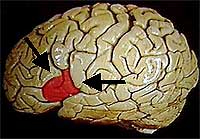 | Genetic Control of Brain Symmetry |  |
 | Genetic Control of Brain Symmetry |  |
|
By Melissa Lee Phillips Neuroscience for Kids Consultant May 7, 2002 | |
Broca's Area
Wernicke's Area
Images courtesy of |
Scientists have found that the brains of left-handed people are shaped
differently than those of right-handed people. Right-handers usually have
asymmetric brains; their left cerebral hemispheres tend to be larger than
their right hemispheres. In particular, Broca's and Wernicke's areas, two
regions involved with language, are likely to be much larger in the left
hemisphere than in the right. In contrast to right-handers, left-handers
generally have more symmetrical brains, with similarly sized language
centers in each hemisphere. One possible explanation for this observation is that most right-handers have a "right-shift" set of genes. When these genes are active, the person will be right-handed and most likely will have a larger left cerebral hemisphere. If a person does not have active forms of these "right-shift" genes, there will be no genetic control over handedness or brain symmetry. These people can be either left- or right-handed, and their brains will be more symmetrical. A study by Daniel Geschwind and his colleagues at the University of California in Los Angeles adds support to the theory of genetic control over brain symmetry. Geschwind and his team measured the volume of the left and right cerebral cortex in identical male twins and compared these volumes to handedness. Consistent with previous research, the left-handers had more symmetrical brains than the right-handers. Additionally, they compared the hemispheric volumes in each set of twins and found that right-handed twin sets were more likely to have similarly shaped brains than were twin sets in which at least one man was left-handed. These results support the "right-shift" genetic theory. It seems that there is genetic control over the asymmetry present in the brains of most right-handers. The loss of asymmetry in left-handed people may reflect a lack of this genetic control. |
|
Reference and more information:
|
| GO TO: | Neuroscience In The News | Explore the Nervous System | Table of Contents |
![[email]](./gif/menue.gif) Send E-mail |
 Fill out survey |
 Get Newsletter |
 Search Pages |
 Take Notes |